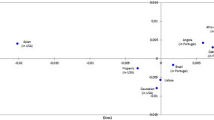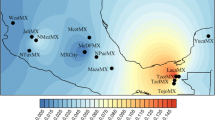Abstract
Polymorphism of CGG and GCC trinucleotide repeats, whose expansions at the FRAXA and FRAXE loci have been identified as causative mutations in two forms of mental retardation, was studied in Slavic population of Tomsk. At the FRAXA locus a total of 31 allelic variants ranging from 8 to 56 copies of CGG repeat with two modal classes of 28–29 and 18–20 repeat units (with the frequencies of 24.6 and 11.5% respectively) were revealed. Compared to other populations, this locus was characterized by unusually high frequency of intermediate alleles with the sizes of more than 40 CGG repeat units (12.4%). Since intermediate repeats of the FRAXAlocus were more prone to instability than normal alleles, it was suggested that Slavic population of Siberia had higher risk of the development of FMR1 dynamic mutations, giving rise to the Martin–Bell syndrome. The FRAXE allele frequency distribution was demonstrated to be normal with 18 allelic variants ranging from 9 to 27 GCC repeat units. In the population of Tomsk this locus had higher than in other populations frequency (26.7%) of short (less than 15 repeat units in size) alleles. In addition, in the Tomsk population both loci were characterized by high level of heterozygosity and low frequencies of modal allele classes. These results can be explained by the high level of outbreeding typical of the population of Siberia.
Similar content being viewed by others
REFERENCES
Richards, R.I. and Sutherland, G.R., Dynamic Mutation: A New Class of Mutation Causing Human Disease, Cell (Cambridge, Mass.), 1992, vol. 70, pp. 709-712.
Morton, N.E. and Macpherson, J.N., Population Genetics of the Fragile-X Syndrome: Multiallelic Model for the FMR1 Locus, Proc. Natl Acad. Sci. USA, 1992, vol. 89, pp. 4215-4217.
Imbert, G., Kretz, C., Johnson, K., et al., Origin of the Expansion Mutation in Myotonic Dystrophy, Nat. Genet., 1993, vol. 4, no. 1, pp. 72-76.
Rubinszshein, D.C., Amos, W., Leggo, J., et al., Mutational Bias Provides a Model for the Evolution of Huntington's Disease and Predicts a General Increase in Disease Prevalence, Nat. Genet., 1994, vol. 5, pp. 525-531.
Murray, A., Youings, S., Dennis, N., et al., Population Screening at the FRAXA and FRAXE Loci: Molecular Analyses of Boys with Learning Difficulties and Their Mothers, Hum. Mol. Genet., 1996, vol. 5, no. 6, pp. 727-735.
Larsen, L.A., Grónskov, K., Norgaard-Pedersen, B., et al., High-Throughput Analysis of Fragile X (CGG)n Alleles in the Normal and Premutation Range by PCR Amplification and Automated Capillary Electrophoresis, Hum. Genet., 1997, vol. 100, pp. 564-568.
Li, C.C., First Course in Population Genetics, Pacific Grove: Boxwood, 1976.
Borovikov, V.P., Populyarnoe vvedenie v programmu STATISTICA (Accessible Introduction to the STATISTICA Program), Moscow: Komp'yuterPress, 1998.
Kunst, C.B., Zerylnick, C., Karickhoff, L., et al., FMR1 in Global Population, Am. Hum. Genet., 1996, vol. 58, pp. 513-522.
Fu, Y.-H., Kuhl, D.P.A., Puzzuti, A., et al., Variation of the CGG Repeat at the Fragile X Site Results in Genetic Instability: Resolution of the Sherman Paradox, Cell (Cambridge, Mass.), 1991, vol. 67, pp. 1047-1058.
Chiang, S.-C., Lee, Y.-M., Wang, T.-R., and Hwu, W.-L., Allele Distribution at the FMR1 Locus in the General Chinese Population, Clin. Genet., 1999, vol. 55, pp. 352-355.
Zong, N., Lui, X., Gou, S., et al., Distribution of FMR1 and Associated Microsatellite Alleles in the Normal Chinese Population, Am. J. Med. Genet., 1994, vol. 51, pp. 417-422.
Crawford, D.C., Schwartz, C.E., Meadows, K.L., et al., Am. J. Hum. Genet., 2000, vol. 66, pp. 480-493.
Morris, A., Morton, N.E., Collins, A., et al., An N-Alleles Model for Progressive Amplification in the FMR1 Locus, Proc. Natl Acad. Sci. USA, 1995, vol. 92, pp. 4833-4837.
Haddad, L.A., Aguiar, M.J.B., Costa, S.S., et al., Fully Mutation and Gray-Zone FRAXA Alleles in Brazilian Mentally Retarded Boys, Am. J. Med. Genet., 1999, vol. 84, pp. 198-201.
Kunst, C.B. and Warren, S.T., Cryptic and Polar Variation of the Fragile Z Could Result in Redispotion Normal Alleles, Cell (Cambridge, Mass.), 1994, vol. 54, pp. 853-861.
Eichler, E.E., Holden, J.A., Popovich, B.W., et al., Length of Uninterrupted CGG Repeats Determines Instability in the FMR1 Gene, Nat. Genet., 1994, no. 8, pp. 88-94.
Zhong, N., Ju, W., Pietrofesa, J., et al., Fragile X “Gray Zone” Alleles: AGG Patterns, Expansion Risk, and Associated Haplotypes, Am. J. Med. Genet., 1996, vol. 64, pp. 261-265.
Knight, S.J.L., Voelckel, M.A., Hirst, M.C., et al., Triplet Repeat Expansion at the FRAXE and X-Linked Mild Mental Handicap, Am. J. Hum. Genet., 1994, vol. 55, pp. 81-86.
Zong, N., Ju, W., Curley, D., et al., A Survey of FRAXE Allele Size in Three Populations, Am. J. Med. Genet., 1996, vol. 65, pp. 415-419.
Ritchie, R.J., Chakraborti, L., Knight, S.J.L., et al., Population Genetics of the FRAXE and FRAXF GCC Repeats, and a Novel CGG Repeat, in Xq28, Am. J. Med. Genet., 1997, vol. 73, pp. 463-469.
Váisánen, M.L., Haataja, R., and Leisti, J., Decrease in the CGGn Trinucleotide Repeat Mutation of the Fragile X Syndrome to Normal Size Range during Parental Transmission, Am. J. Hum. Genet., 1996, vol. 59, pp. 540-546.
Knight, S.J.L., Flannery, A.V., et al., Trinucleotide Repeat Amplification and Hypermethylation of a CpG Island in FRAXE Mental Retardation, Cell (Cambridge, Mass.), 1993, vol. 74, pp. 127-134.
Kucher, A.R., Ivanova, O.F., Puzyrev, V.P., et al., Genetic Demographic Characterization of a Modern Siberian Town (Exemplified by Tomsk), Genetika (Moscow), 1995, vol. 30, no. 2, pp. 276-281.
Amos, W., Sawcer, S.J., Feakes, R.W., et al., Microsatellites Show Mutational Bias and Heterozygote Instability, Nat. Genet., 1996, vol. 13, no. 4, pp. 390-391.
Weber, J.L. and Wong, C., Mutation of Human Short Tandem Repeats, Hum. Mol. Genet., 1993, vol. 2, pp. 1123-1128.
Author information
Authors and Affiliations
Rights and permissions
About this article
Cite this article
Tolmacheva, E.N., Nazarenko, S.A. Polymorphism of Trinucleotide Repeats at Loci FRAXA and FRAXE in the Population of Tomsk. Russian Journal of Genetics 38, 205–209 (2002). https://doi.org/10.1023/A:1014394329797
Issue Date:
DOI: https://doi.org/10.1023/A:1014394329797




